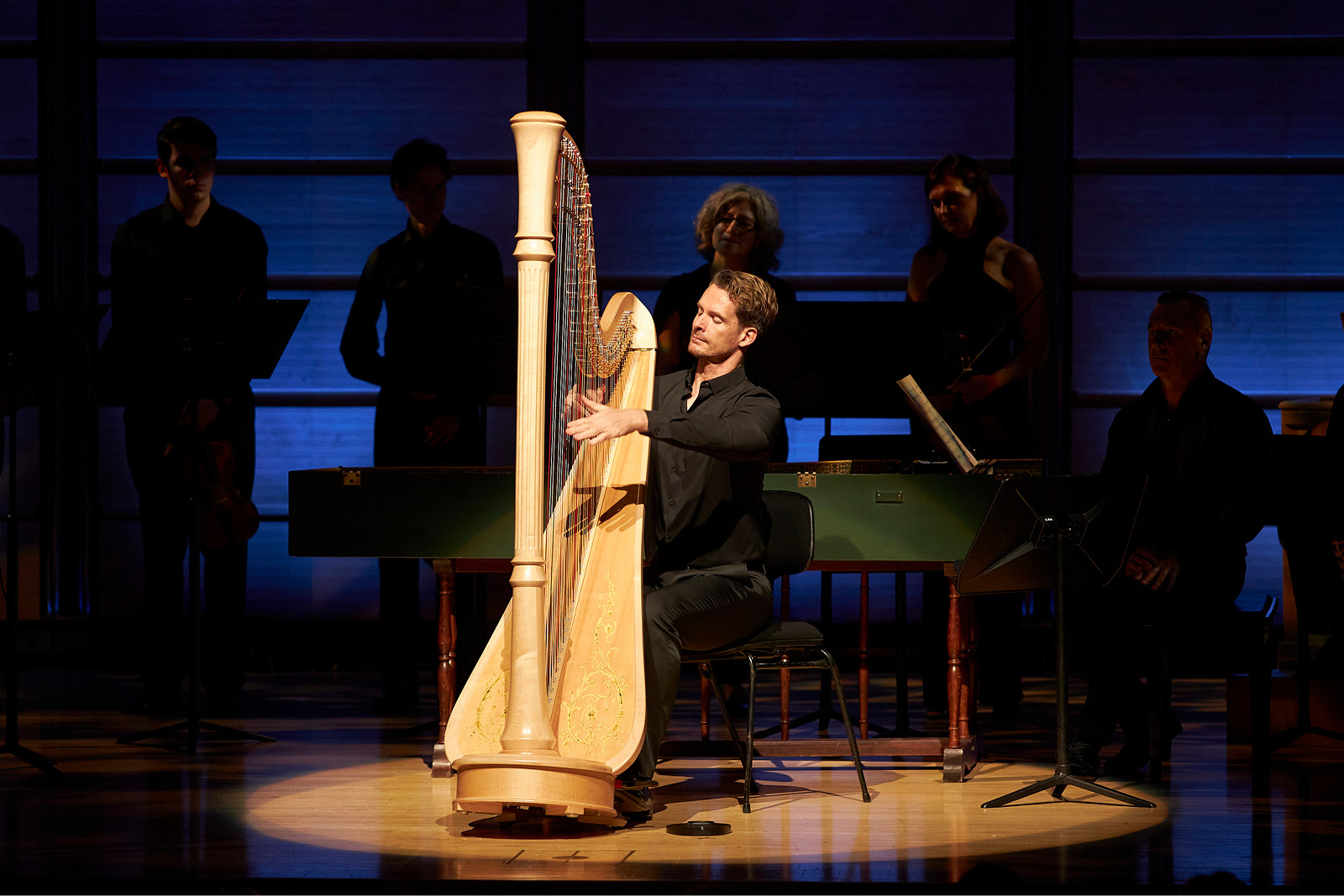Xavier de Maistre has returned to kick off the Australian Brandenburg Orchestra’s first tour for 2020, which began in Sydney’s City Recital Hall last night, the French harpist – last in town for the Brandenburgs’ 2018 season – bringing flair and subtlety to Vivaldi’s Venice.
 Xavier de Maistre and the Australian Brandenburg Orchestra. Photo © Keith Saunders
Xavier de Maistre and the Australian Brandenburg Orchestra. Photo © Keith Saunders
Venice was Vivaldi’s birthplace, the city in which he was ordained as a priest, and where he enjoyed considerable success as an opera composer. It was also the city of his decades-long association with the orphanage Ospedale della Pietà and it’s formidable (if the music he wrote for it is anything to go by) all-female music ensemble, which resulted in a massive output of concertos – he wrote over 500 all up, most of them for the Pietà. This program – based on one De Maistre recorded in 2012 with German period instrument band l’arte del mondo and Werner Ehrhardt – celebrates both the music of Vivaldi as well as his Venetian contemporaries, such as Alessandro Marcello, Tomaso Albinoni and Giovanni Battista Pescetti – whose legacies have since been obscured by the long shadow of the Red Priest.
Following the bright curtain-raiser of the Sinfonia from the opera L’Olimpiade – performed with Vivaldian verve by a reduced-forces Brandenburg Orchestra led by Paul Dyer from the harpsichord – De Maistre took to the stage for Vivaldi’s RV 93 lute concerto, likely written in Prague, commissioned by Count Johann Joseph von Wrtby.
Vivaldi’s scoring, designed not to overpower the softer lute, works a treat for the harp, De Maistre’s instrument – wielded with nimble flair – sounding round and plummy against the baroque strings and harpsichord. The swaying second movement was particularly arresting, and while there was a moment in the twinkling finale when harpist and orchestra seemed to come slightly unglued, they recovered quickly.
Lean, unison strings contrasted with floral harp figures in Marcello’s Concerto in D Minor (S D935), originally written for oboe soloist. There was a beautiful duet between harp and violas in the first movement, while De Maistre demonstrated just how whisper quiet he can play in the Adagio.
The solo showpiece La Mandoline by 19th-century harp virtuoso and composer Elias Parish-Alvars – who made the most of innovations in the instrument’s design – might have been a stretch as far as the Vivaldi’s Venice theme was concerned (it was inspired by a trip to Naples) but it nonetheless allowed the audience a chance to take in De Maistre’s impressive virtuosity and skill with colour.
Concertmaster Shaun Lee-Chen brought singing violin lines to the first movement of Albinoni’s Opus 2, No 3 Sonata, Dyer now at the organ, but there was an uneasiness to the counterpoint of the second movement and the final Allegro felt strangely ponderous.
The band brought plenty of energy to the third of Vivaldi’s L’estro armonico concertos, however, De Maistre returning to close the concert’s first half. From the lavish virtuosity of the first movement, the second saw him weaving finer melodic lines between rich chords with the strings, the harp giving the Concerto a more fragile texture than the original violin, finishing with an elegant, rather than break-neck, Allegro.
Dyer brought a thoughtful sense of space to the harpsichord cadenza that follows the first flourish of Giovanni Lorenzo Gregori’s Concerto Grosso Op. 2 No 2. This was apparently the Australian premiere of this work by the contemporary of Vivaldi, who hailed not from Venice but Lucca, in Tuscany. While there were a few intonation issues in the quiet Largo – of which the harpsichord was also a feature – the finale was bright and bustling.
The ‘Albinoni Adagio’, which opened with Dyer’s organ and pizzicato strings, is of dubious provenance – it was ‘reconstructed’ from a fragment musicologist Remo Giazotto supposedly found in a library in Dresden but never allowed anybody else to see – but it has been incredibly successful, featuring widely in film soundtracks from Peter Weir’s Gallipoli to superhero comedy Kick-Ass. Here the Brandenburgs gave a sombre, measured account, with Lee-Chen producing an especially fine, dark-hued sound on his violin.
De Maistre returned for what was perhaps the finest performance of the evening, Pescetti’s C Minor Sonata (originally written for harpsichord), the harpist lyrical in the finely-wrought counterpoint of the first movement and bringing spider-web delicacy to the second, before carrying off the flurrying notes of the finale with aplomb.
Winter from Vivaldi’s Four Seasons brought the official program to a close, harp giving the work a very effective crystalline iciness, which softened in the ‘fireside’ second movement before shrinking to eerie trepidation in the last movement.
There were some magical moments in this concert, but there was a slight uneasiness that pervaded the performances and dampened the otherwise joyful Venetian atmosphere – these kinks will no doubt work themselves out over the course of the tour, however.
To cap off the evening De Maistre reprised an encore he performed in 2018, Félix Godefroid’s Carnaval de Venise – an appropriately festive, glittering finish.
The Australian Brandenburg Orchestra’s Vivaldi’s Venice tours Sydney, Brisbane and Melbourne until March 13











Comments
Log in to join the conversation.